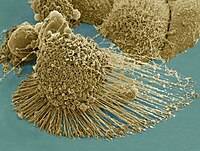
Photo from wikipedia
Cellular senescence contributes to tumor regression through both cell autonomous and non-autonomous mechanisms. Drugs inducing cancer cell senescence and modulating senescence-associated secretory phenotype (SASP) render advantage to the cancer treatment.… Click to show full abstract
Cellular senescence contributes to tumor regression through both cell autonomous and non-autonomous mechanisms. Drugs inducing cancer cell senescence and modulating senescence-associated secretory phenotype (SASP) render advantage to the cancer treatment. Breast cancer remains the second most cause of female cancer mortality, among which triple-negative breast cancer (TNBC) has a more aggressive clinical course. Our study showed that in TNBC cell lines including MDA-MB-231 and 4T1 cells, moderate concentrations of wogonin (5, 7-dihydroxy-8-methoxy-2-phenyl-4h-1-benzopyran-4-one) (50–100 μM) not only induced permanent proliferation inhibition, but also increased P16 expression, β-galactosidase activity, senescence-associated heterochromatin foci and SASP, which are the typical characteristics of cellular senescence. Moreover, results showed that wogonin-induced senescence was partially attributed to the reactive oxygen species (ROS) accumulation upon wogonin treatment in MDA-MB-231 cells, since elimination of ROS by N-acetylcysteine (NAC) was able to repress wogonin-induced β-galactosidase activity. Mechanistically, wogonin reduced the expression of TXNRD2, an important antioxidant enzyme in controlling the levels of cellular ROS, by altering the histone acetylation at its regulatory region. In addition, senescent MDA-MB-231 cells induced by wogonin exhibited activated NF-κB and suppressed STAT3, which were recognized as regulators of SASP. SASP from these senescent cells suppressed tumor cell growth, promoted macrophage M1 polarization in vitro and increased immune cell infiltration in xenografted tumors in vivo. These results reveal another mechanism for the anti-breast cancer activity of wogonin by inducing cellular senescence, which suppresses tumor progression both autonomously and non-autonomously.
Journal Title: Archives of Toxicology
Year Published: 2020
Link to full text (if available)
Share on Social Media: Sign Up to like & get
recommendations!